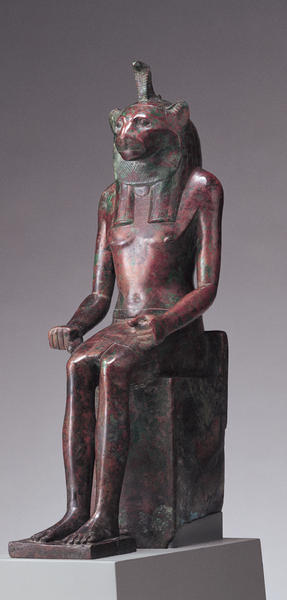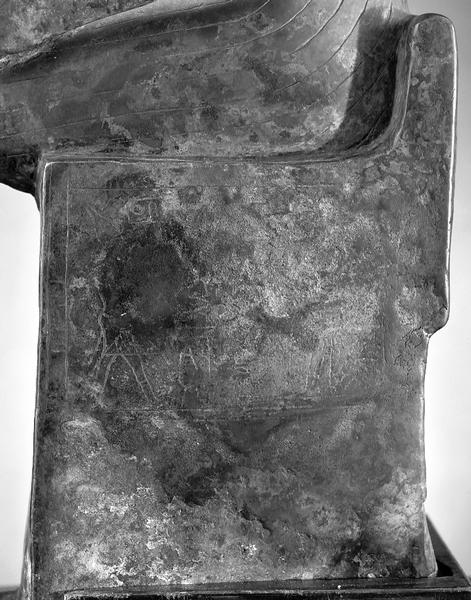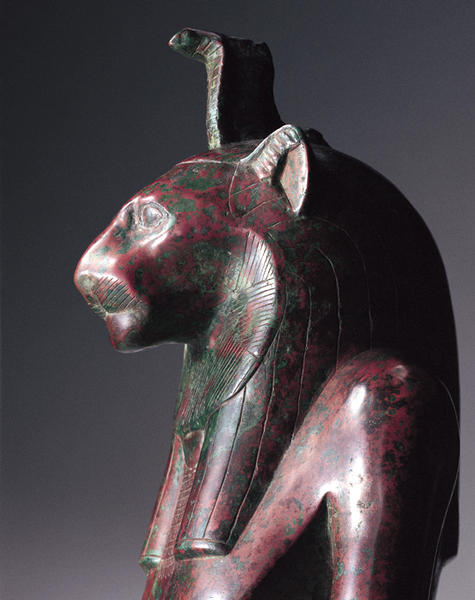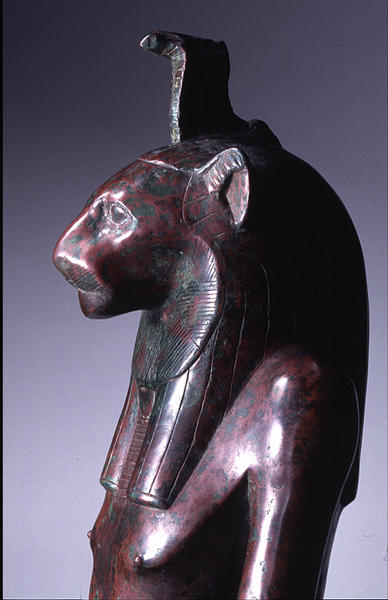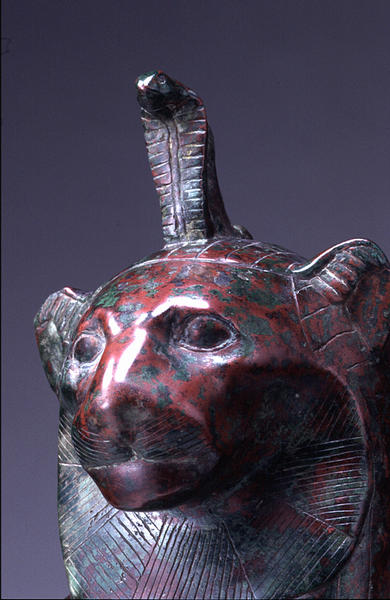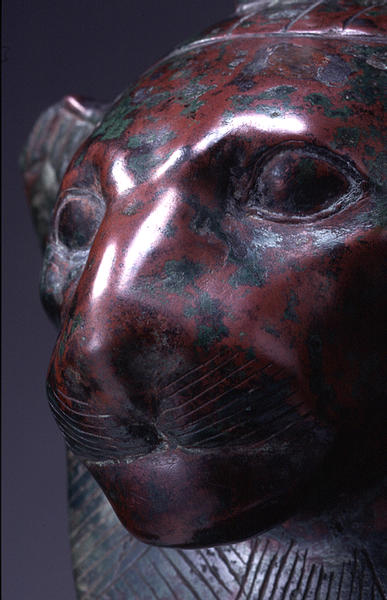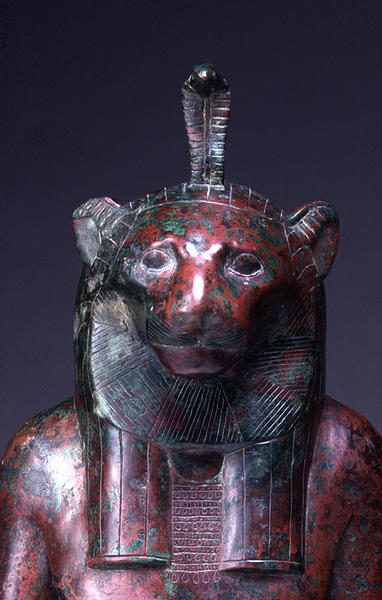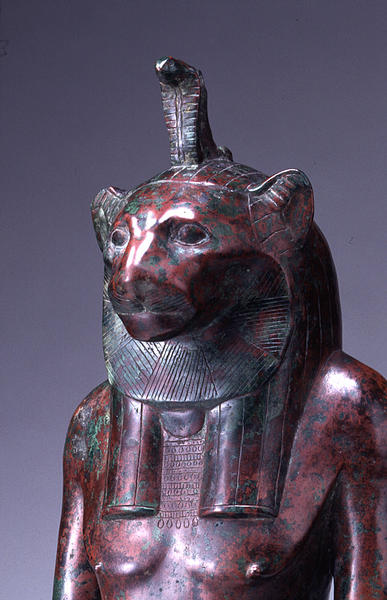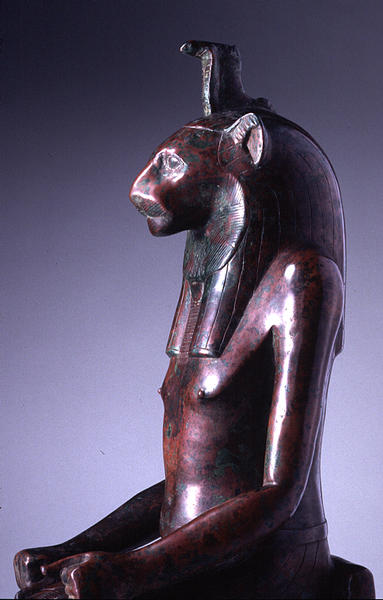Lion-headed Deity
- Egypt
- Egypt, Late Dynasty 25 - Dynasty26
- about 690 - 525 B.C.
- Bronze
- H-61.5 D-33 W-17.5
Catalogue Entry
Remarkable for its size, high level of technical execution, and excellent state of preservation, this Egyptian bronze depicts an enthroned male lion-headed deity. The god is seated on a low cuboidal throne, which is engraved with scenes on the sides and back, and once held an ankh (symbol of life) in its proper right hand and a long was- or wadj-scepter in the other, features shared by another large-scale Egyptian bronze in the Shumei collection (cat. no. 8). The deity is surmounted by a headdress with a single erect cobra, wears a wesekh collar composed of six rows of tubular and six rows of oval beads, and a shendyt, or wrapped kilt. In addition to indicating the necklace and garment, engraved lines articulate the long parallel locks of the tripartite wig and embellish the wide ruff encircling the lower portion of the lion's head. The arms, torso, and legs are well proportioned and naturalistic, providing clear evidence that a male deity is indicated, with flat, ridge-like pectorals.
Writing in 1967, the accomplished French Egyptologist Jacques Vandier compared forty-five enthroned lion-headed bronze figures, measuring from 20 to 58 cm in height.1 Based on iconography and inscriptions, he distinguished two deities--the goddess Wadjet, Mistress of Buto of the Delta, and her son Horus, whose cult was also established at Buto. The Shumei lion-headed deity was included as an addendum to this study, with the notation that it was accessible to him in a private collection at that time and should be considered as a depiction of the lion-headed Horus.2 Of the ten other lion-headed bronze images of Horus identified by Vandier,3 a large (58 cm) figure now in the Berlin Museum most closely compares with the Shumei example, and bears a significant text. A dedicatory inscription on the socle of the Berlin figure reads: "Horus, son of Wadjet, gives life to Horwadja...."4 Not only does this identify the deity as Horus, but it narrows the many personifications of Horus through affiliation with his mother Wadjet. By association, it is likely that the Shumei figure depicts the same deity, and was commissioned for use in the cult center of Buto, located in the sixth nome of the Delta.
The cuboidal thrones from this series of bronzes bear varied images--offering scenes, feather patterns, and empaneled designs of heraldic plants. The throne of the Shumei figure is particularly interesting, with two rare depictions of royal offering scenes. More clearly visible is the scene on the left side (fig. 1), a king wearing the crown of Upper Egypt and a triangular kilt standing before an offering table and a seated deity. The remains of an inscription enclosed within a cartouche provide further indication of the royal aspect of the scene, yet it is largely illegible.5
Lacking clear archaeological data, Vandier based his dating for the series of lion-headed figures on orthographic evidence from three examples6 and ascribed the series to the late Twenty-fifth or early Twenty-sixth Dynasty. The high level of technical expertise evidenced by other bronzes from this period further corroborates this attribution. The production of substantial images of the regional deity, Horus of Buto, who originated in Lower Egypt, is logical at this time when a local dynasty of Sais in the Delta was rising in influence and consolidating political power throughout the country.
NT
1. Vandier 1967, pp. 7-75.
2. Vandier 1967, pp. 73-75.
3. Vandier 1967, p. 49, nos. 1-10.
4. Roeder 1956, pp. 69-70, pl.12a,b,d,e, figs. 87-90; Vandier 1967, pp. 23-25, fig. 9.
5. Vandier (1967, p. 75) read the first sign as a solar disk (Re'), with a tentative identification of the second as a scarab (hpr), possibly providing the name Khepekare' (Nectanebo I, r. 380-362). The second sign also resembles an s (folded cloth?), and might indicate Darius I (r. 521-486 B.C.) or the weh (swab) of Wehibre' (Psamtik I, r. 664-610). Unfortunately, extensive technical analysis by the Conservation Center of the Los Angeles County Museum of Art has not revealed any additional information on this fragmentary inscription.
6. Vandier 1967, pp. 15-17, 21-22, 65.
